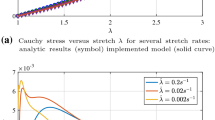Abstract
Purely elastic material models have a limited validity. Generally, a certain amount of energy absorbing behaviour can be observed experimentally for nearly any material. A large class of dissipative materials is described by a time- and frequency-dependent viscoelastic constitutive model. Typical representatives of this type are polymeric rubber materials. A linear viscoelastic approach at small and large strains is described in detail and this makes a very efficient numerical formulation possible. The underlying constitutive structure is the generalized Maxwell-element. The derivation of the numerical model is given. It will be shown that the developed isotropic algorithmic material tensor is even valid for the current configuration in the case of large strains. Aspects of evaluating experimental investigations as well as parameter identification are considered. Finally, finite element simulations of time-dependent deformations of rubber structures using mixed elements are presented.
Similar content being viewed by others
Author information
Authors and Affiliations
Additional information
Communicated by S. N. Atluri, 5 September 1996
Rights and permissions
About this article
Cite this article
Kaliske, M., Rothert, H. Formulation and implementation of three-dimensional viscoelasticity at small and finite strains. Computational Mechanics 19, 228–239 (1997). https://doi.org/10.1007/s004660050171
Issue Date:
DOI: https://doi.org/10.1007/s004660050171




